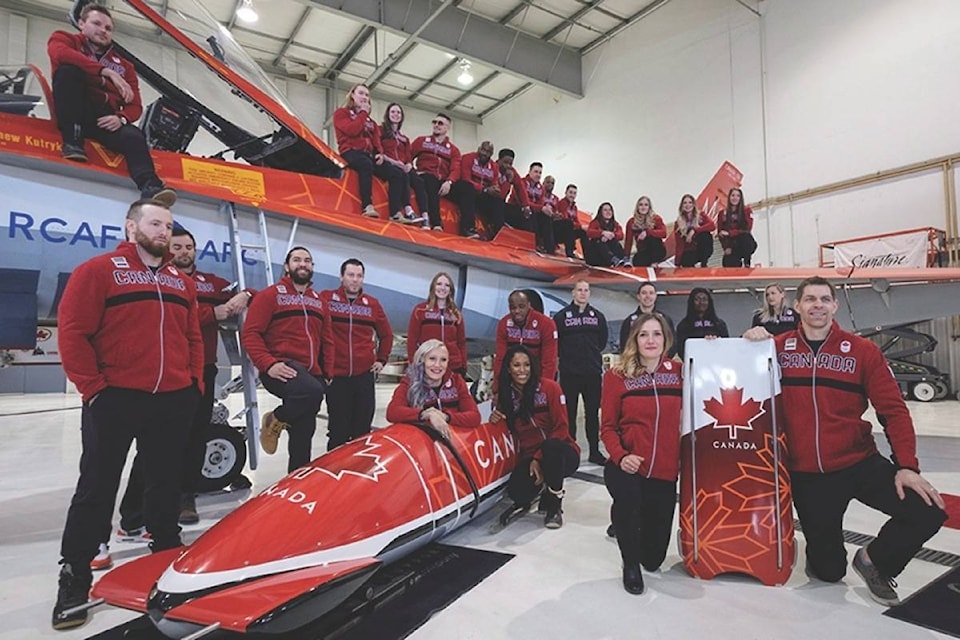CALGARY — Canada’s bobsleds and skeleton sleds might not break the sound barrier in Pyeongchang, South Korea, but they’re decorated to look like they could.
The 18 bobsledders and six skeleton racers sliding in the Winter Olympics were introduced Wednesday at an airplane hangar in northeast Calgary, along with a new design for their sleds.
They bear the Canada 150 paint scheme of the Royal Canadian Air Force’s CF-18 demonstration Hornet.
“My first thought was ‘oh man, our sled tech has to put on these giant stickers now. That’s going to be a pain in the butt for him’ but I think the design is really cool,” pilot Kaillie Humphries said.
“An all red-and-white sled, this is probably the most Canadian sled we’ve ever had at any of the games.”
The opening ceremonies are Feb. 9. Humphries, who will attempt to win a third straight gold, leads a team with solid medal potential in men’s two-man bobsled well as women’s skeleton.
Brakeman Lascelles Brown will compete in his fifth Winter Games. The 43-year-old from Calgary won bronze with Canada’s 2010 four-man team piloted by Lyndon Rush, as well as two-man silver in 2006 with Pierre Lueders.
Justin Kripps of Summerland, B.C., and Chris Spring of Priddis, Alta., piloted Canada’s two-man sleds to first and third respectively in this season’s overall World Cup standings. Calgary’s Elisabeth Vathje won four World Cup medals this winter in women’s skeleton.
2018 marks the first time Canada qualified the maximum number of men’s and women’s sleds for the Winter Olympics.
“These athletes know what it takes to win and will head to Korea with one goal: put the Maple Leaf on the Olympic podium at the sliding venue,” said Chris Le Bihan, high-performance director for Bobsleigh Canada Skeleton.
Edmonton’s Alysia Rissling and Christine de Bruin of Stony Plain, Alta., will pilot the other two women’s sleds.
They’ll draw from the brake pool of Heather Moyse of Summerside, P.E.I., Phylicia George of Markham, Ont., and Melissa Lotholz of Barrhead, Alta. Moyse won gold with Humphries in both 2010 and 2014.
Joining Brown in the men’s pool of brakemen are Jesse Lumsden of Burlington, Ont., Edmonton’s Neville Wright and Bryan Barnett, Ben Coakwell of Moose Jaw, Ont., Ottawa’s Seyi Smith, Alex Kopacz of London, Ont., Cam Stones of Whitby, Ont., and Josh Kirkpatrick of London, Ont.
The men’s skeleton team consists of Dave Greszczszyn of Brampton, Ont., Calgary’s Barrett Martineau and Kevin Boyer of Sherwood Park., Alta.
Ottawa’s Mirela Rahneva and Jane Channell of North Vancouver, B.C., round out the women’s team.
The look of their sleds is influenced by the wings of the CF-18, which has a maximum speed of Mach 1.8, according to a man who flies them.
“It’s pretty cool for me because I’ve been a long-time fan of the Olympics,” Major Phil Meikle said. “I’ve followed bobsled, had a couple of friends who have been part of the bobsled team over the last 10 or 15 years.
“I’m a big fan of the design they did for that demo jet last year, so it will be very interesting.”
The sliding team has spent time with the Armed Forces at CFB Wainwright to mentally prepare for competition, including a two-day overnight training operation in 2016.
“With the military, we’ve gotten really close over the last four years,” Humphries said. “There are a lot of similarities. You can really see that represented on our sleds this year.
“I don’t think it’s important for the sled to make a statement, but I think it’s important we really feel Canadian, that we feel strong and empowered in who we are as athletes. I think this sled design definitely does that.”
Toronto graphic arts student Josh Dornan incorporated the style of the Hornet honouring Canada’s 150th birthday in 2017 into Olympic sleds.
“Obviously last year being Canada’s 150th, this jet has spent a lot of time in the sky across the country and so we wanted to capture what it felt like when this massive, powerful machine came across the sky and you can see our flag on it,” Dornan explained.
“It’s a really crazy moment when you see this thing, so how do we translate that onto sleds we bring to Korea and have our athletes race down and have that same impact?”
The Canada 150 jet was graphic designer Jim Belliveau’s last project as a civil servant for the RCAF before his retirement.
“There’s going to be millions of eyes on that sled, millions of eyes on our athletes,” Belliveau said. “That means so much to me. I want to see that thing come back home loaded with gold.”
